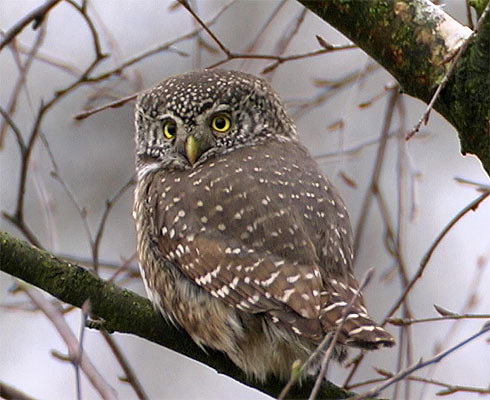(→Identification: orientale) |
|||
| Line 21: | Line 21: | ||
Two subspecies are recognized, ''Glaucidium passerinum passerinum'' in the western part of the range and ''Glaucidium passerinum orientale'' in the eastern part. They intergrade in western Siberia and the Altai Mountains. First described by Carolus Linnaeus in 1758. | Two subspecies are recognized, ''Glaucidium passerinum passerinum'' in the western part of the range and ''Glaucidium passerinum orientale'' in the eastern part. They intergrade in western Siberia and the Altai Mountains. First described by Carolus Linnaeus in 1758. | ||
| − | The Eurasian | + | The Eurasian Pygmy-Owl is sometimes considered to form a superspecies with the [[Collared Owlet]], the [[Pearl-spotted Owlet]], the [[Northern Pygmy Owl]] and the [[Mountain Pygmy Owl]]. However, new DNA evidence denies a close relation to the Northern Pygmy-Owl of North America. |
==Habitat== | ==Habitat== | ||
Revision as of 18:37, 14 September 2007
| This article is a stub. This article is short and lacking information. You can help the BirdForum Opus by expanding it. |
- Glaucidium passerinum
Identification
Length: Males 15.2-17cm (6-6.7"); females 17.4-19cm (6.8-7.5") Weight: Males 50-65g (1.76-2.3oz); females 67-77g (2.36-2.7oz) Mainly dark rufous to greyish-brown above, with whitish spots; breast streaked brown and off-white, with mottled brown flanks; marked white half collar around nape; tail brown to grey-brown, with 5 narrow, off-white bars; round head, no ear tufts; face whitish with brown streaks; eyes yellow; bill yellowish; legs and toes are feathered. The subspecies orientale has paler upperparts with purer white and more sharply defined spots. Also the breast and flanks are more strongly marked brown.
The smallest European owl, it often perches at the top of trees.
Distribution
Boreal forests of Scandinavia, Finland, Estonia, Latvia, northwest and central Russia across to Siberia, including Sakhalin and some parts of northeastern China. Also occuring in mountains of central and eastern Europe, particulary in the Alps (France, Italy, Switzerland, Austria, Germany, Slovenia), the Carpathian Mountains (Slovakia, Romania) and the Ore mountains (Germany, Czech Republic).
Adults are generally resident, but sometimes move to lower altitudes (south) in severe winters. Immatures often roam about in Autumn and Winter, and have even been seen as far west as Britain.
Taxonomy
Two subspecies are recognized, Glaucidium passerinum passerinum in the western part of the range and Glaucidium passerinum orientale in the eastern part. They intergrade in western Siberia and the Altai Mountains. First described by Carolus Linnaeus in 1758.
The Eurasian Pygmy-Owl is sometimes considered to form a superspecies with the Collared Owlet, the Pearl-spotted Owlet, the Northern Pygmy Owl and the Mountain Pygmy Owl. However, new DNA evidence denies a close relation to the Northern Pygmy-Owl of North America.
Habitat
Mainly coniferous forest in the boreal zone and corresponding montane coniferous and mixed forest in higher mountains. Prefers semi-open mature forest with clearings. Nest sites are usually found in moist or swampy areas, near a water source and with groups of younger spruces nearby.
Behaviour
Bird Song
<flashmp3>Glaucidium passerinum (song).mp3</flashmp3>
Listen in an external program





